Analysis of Entrepreneurial Marketing in Small and Medium Enterprises
VerifiedAdded on 2020/10/05
|10
|2606
|136
Report
AI Summary
This report provides an analysis of entrepreneurial marketing practices within Small and Medium Enterprises (SMEs), specifically focusing on those in the Manufacturing sector. The study begins by identifying the distinguishing features of SMEs, such as lower revenue and profit rates, a smaller workforce, concentrated markets, limited location availability, and sole proprietorship structures. The report then delves into the key marketing operational issues faced by SMEs, including challenges in attracting customers, budget constraints, and the complexities of online marketing. Additionally, the report compares standard marketing theories such as Porter’s Five Forces, SWOT Analysis, and Ansoff’s Matrix, highlighting their application and relevance to SMEs. Finally, the report explores core marketing concepts like word-of-mouth and opportunistic marketing, emphasizing their importance for SMEs. The conclusion underscores the significance of entrepreneurial marketing as a successful strategy for new SMEs, emphasizing its role in attracting customers and fostering business growth.
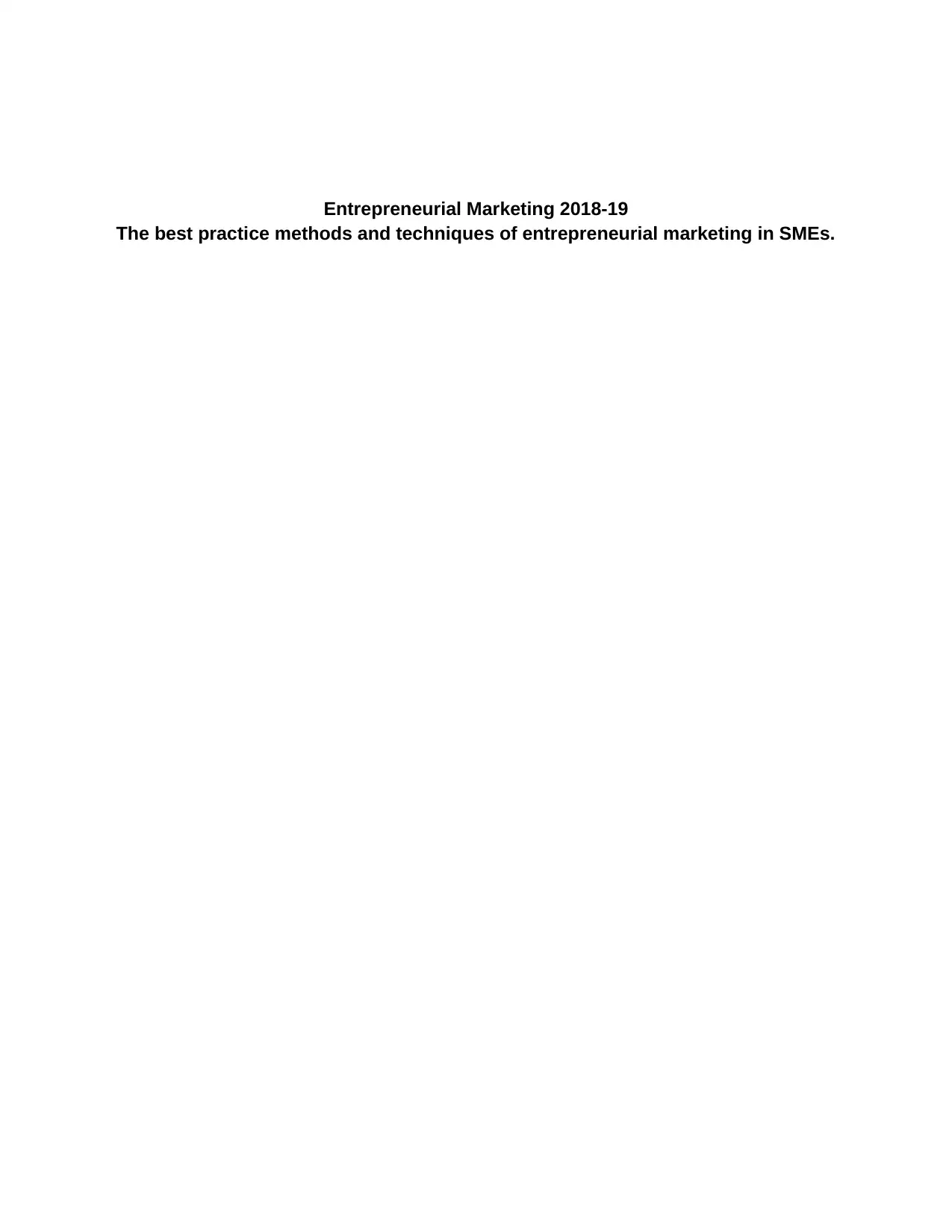
Entrepreneurial Marketing 2018-19
The best practice methods and techniques of entrepreneurial marketing in SMEs.
The best practice methods and techniques of entrepreneurial marketing in SMEs.
Paraphrase This Document
Need a fresh take? Get an instant paraphrase of this document with our AI Paraphraser
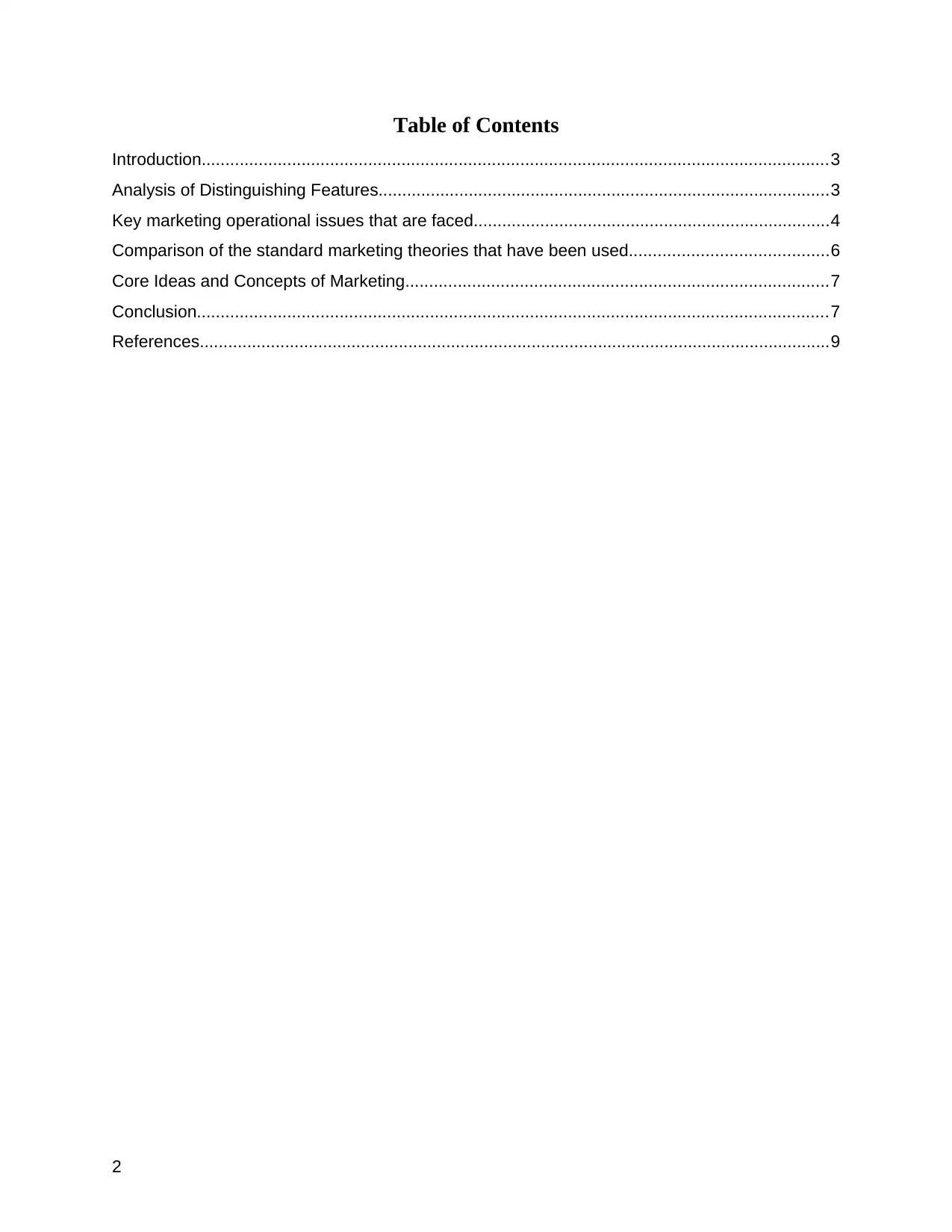
Table of Contents
Introduction....................................................................................................................................3
Analysis of Distinguishing Features...............................................................................................3
Key marketing operational issues that are faced...........................................................................4
Comparison of the standard marketing theories that have been used..........................................6
Core Ideas and Concepts of Marketing.........................................................................................7
Conclusion.....................................................................................................................................7
References.....................................................................................................................................9
2
Introduction....................................................................................................................................3
Analysis of Distinguishing Features...............................................................................................3
Key marketing operational issues that are faced...........................................................................4
Comparison of the standard marketing theories that have been used..........................................6
Core Ideas and Concepts of Marketing.........................................................................................7
Conclusion.....................................................................................................................................7
References.....................................................................................................................................9
2
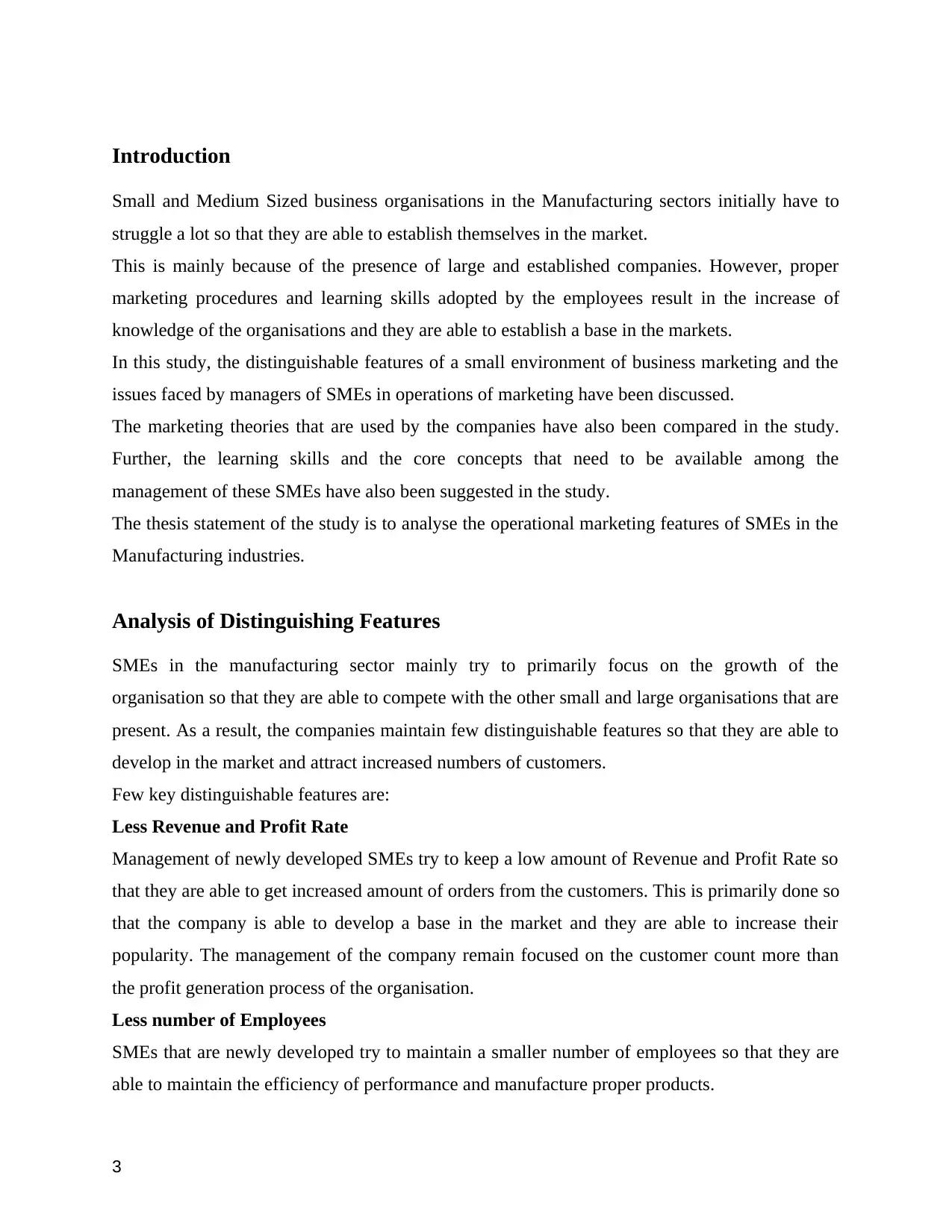
Introduction
Small and Medium Sized business organisations in the Manufacturing sectors initially have to
struggle a lot so that they are able to establish themselves in the market.
This is mainly because of the presence of large and established companies. However, proper
marketing procedures and learning skills adopted by the employees result in the increase of
knowledge of the organisations and they are able to establish a base in the markets.
In this study, the distinguishable features of a small environment of business marketing and the
issues faced by managers of SMEs in operations of marketing have been discussed.
The marketing theories that are used by the companies have also been compared in the study.
Further, the learning skills and the core concepts that need to be available among the
management of these SMEs have also been suggested in the study.
The thesis statement of the study is to analyse the operational marketing features of SMEs in the
Manufacturing industries.
Analysis of Distinguishing Features
SMEs in the manufacturing sector mainly try to primarily focus on the growth of the
organisation so that they are able to compete with the other small and large organisations that are
present. As a result, the companies maintain few distinguishable features so that they are able to
develop in the market and attract increased numbers of customers.
Few key distinguishable features are:
Less Revenue and Profit Rate
Management of newly developed SMEs try to keep a low amount of Revenue and Profit Rate so
that they are able to get increased amount of orders from the customers. This is primarily done so
that the company is able to develop a base in the market and they are able to increase their
popularity. The management of the company remain focused on the customer count more than
the profit generation process of the organisation.
Less number of Employees
SMEs that are newly developed try to maintain a smaller number of employees so that they are
able to maintain the efficiency of performance and manufacture proper products.
3
Small and Medium Sized business organisations in the Manufacturing sectors initially have to
struggle a lot so that they are able to establish themselves in the market.
This is mainly because of the presence of large and established companies. However, proper
marketing procedures and learning skills adopted by the employees result in the increase of
knowledge of the organisations and they are able to establish a base in the markets.
In this study, the distinguishable features of a small environment of business marketing and the
issues faced by managers of SMEs in operations of marketing have been discussed.
The marketing theories that are used by the companies have also been compared in the study.
Further, the learning skills and the core concepts that need to be available among the
management of these SMEs have also been suggested in the study.
The thesis statement of the study is to analyse the operational marketing features of SMEs in the
Manufacturing industries.
Analysis of Distinguishing Features
SMEs in the manufacturing sector mainly try to primarily focus on the growth of the
organisation so that they are able to compete with the other small and large organisations that are
present. As a result, the companies maintain few distinguishable features so that they are able to
develop in the market and attract increased numbers of customers.
Few key distinguishable features are:
Less Revenue and Profit Rate
Management of newly developed SMEs try to keep a low amount of Revenue and Profit Rate so
that they are able to get increased amount of orders from the customers. This is primarily done so
that the company is able to develop a base in the market and they are able to increase their
popularity. The management of the company remain focused on the customer count more than
the profit generation process of the organisation.
Less number of Employees
SMEs that are newly developed try to maintain a smaller number of employees so that they are
able to maintain the efficiency of performance and manufacture proper products.
3
⊘ This is a preview!⊘
Do you want full access?
Subscribe today to unlock all pages.

Trusted by 1+ million students worldwide
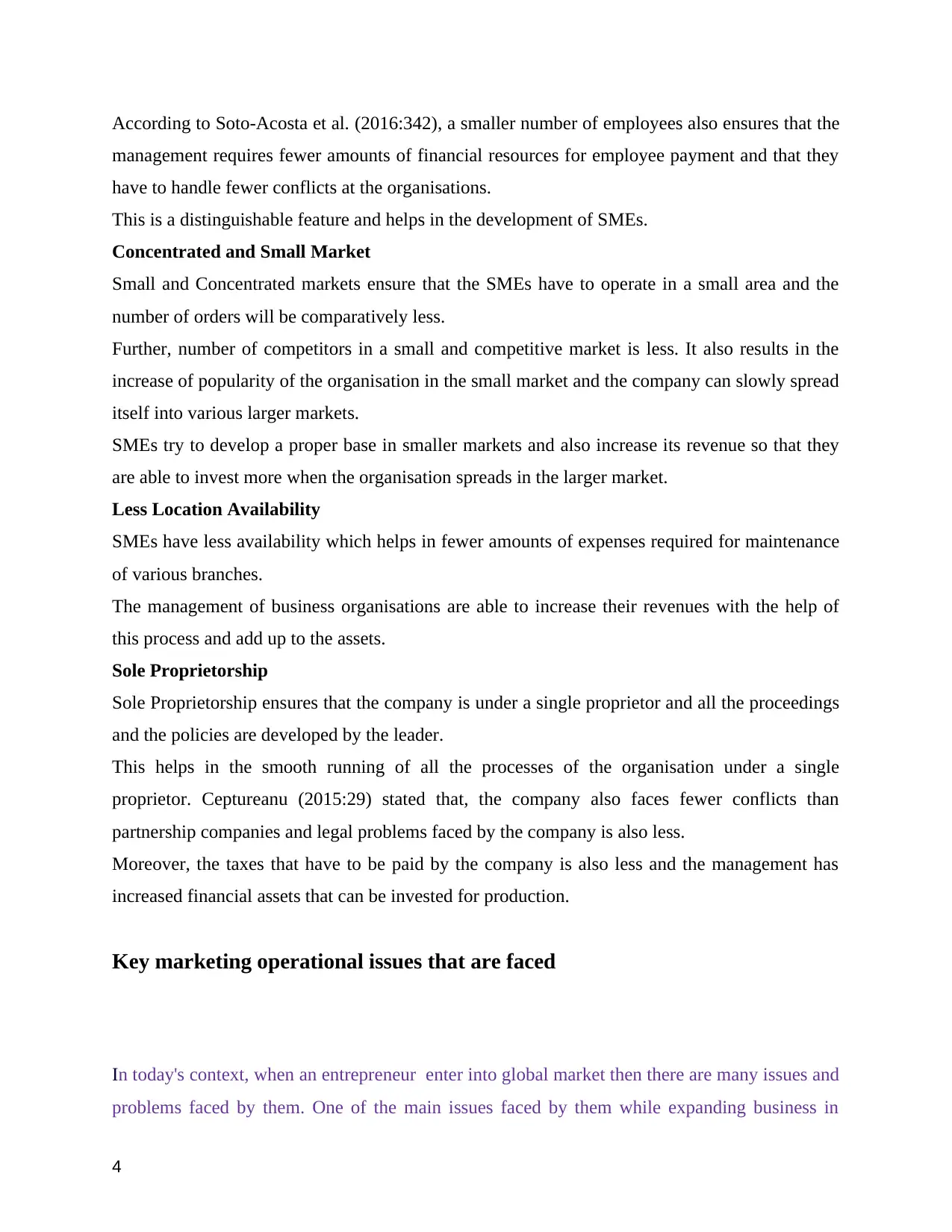
According to Soto-Acosta et al. (2016:342), a smaller number of employees also ensures that the
management requires fewer amounts of financial resources for employee payment and that they
have to handle fewer conflicts at the organisations.
This is a distinguishable feature and helps in the development of SMEs.
Concentrated and Small Market
Small and Concentrated markets ensure that the SMEs have to operate in a small area and the
number of orders will be comparatively less.
Further, number of competitors in a small and competitive market is less. It also results in the
increase of popularity of the organisation in the small market and the company can slowly spread
itself into various larger markets.
SMEs try to develop a proper base in smaller markets and also increase its revenue so that they
are able to invest more when the organisation spreads in the larger market.
Less Location Availability
SMEs have less availability which helps in fewer amounts of expenses required for maintenance
of various branches.
The management of business organisations are able to increase their revenues with the help of
this process and add up to the assets.
Sole Proprietorship
Sole Proprietorship ensures that the company is under a single proprietor and all the proceedings
and the policies are developed by the leader.
This helps in the smooth running of all the processes of the organisation under a single
proprietor. Ceptureanu (2015:29) stated that, the company also faces fewer conflicts than
partnership companies and legal problems faced by the company is also less.
Moreover, the taxes that have to be paid by the company is also less and the management has
increased financial assets that can be invested for production.
Key marketing operational issues that are faced
In today's context, when an entrepreneur enter into global market then there are many issues and
problems faced by them. One of the main issues faced by them while expanding business in
4
management requires fewer amounts of financial resources for employee payment and that they
have to handle fewer conflicts at the organisations.
This is a distinguishable feature and helps in the development of SMEs.
Concentrated and Small Market
Small and Concentrated markets ensure that the SMEs have to operate in a small area and the
number of orders will be comparatively less.
Further, number of competitors in a small and competitive market is less. It also results in the
increase of popularity of the organisation in the small market and the company can slowly spread
itself into various larger markets.
SMEs try to develop a proper base in smaller markets and also increase its revenue so that they
are able to invest more when the organisation spreads in the larger market.
Less Location Availability
SMEs have less availability which helps in fewer amounts of expenses required for maintenance
of various branches.
The management of business organisations are able to increase their revenues with the help of
this process and add up to the assets.
Sole Proprietorship
Sole Proprietorship ensures that the company is under a single proprietor and all the proceedings
and the policies are developed by the leader.
This helps in the smooth running of all the processes of the organisation under a single
proprietor. Ceptureanu (2015:29) stated that, the company also faces fewer conflicts than
partnership companies and legal problems faced by the company is also less.
Moreover, the taxes that have to be paid by the company is also less and the management has
increased financial assets that can be invested for production.
Key marketing operational issues that are faced
In today's context, when an entrepreneur enter into global market then there are many issues and
problems faced by them. One of the main issues faced by them while expanding business in
4
Paraphrase This Document
Need a fresh take? Get an instant paraphrase of this document with our AI Paraphraser
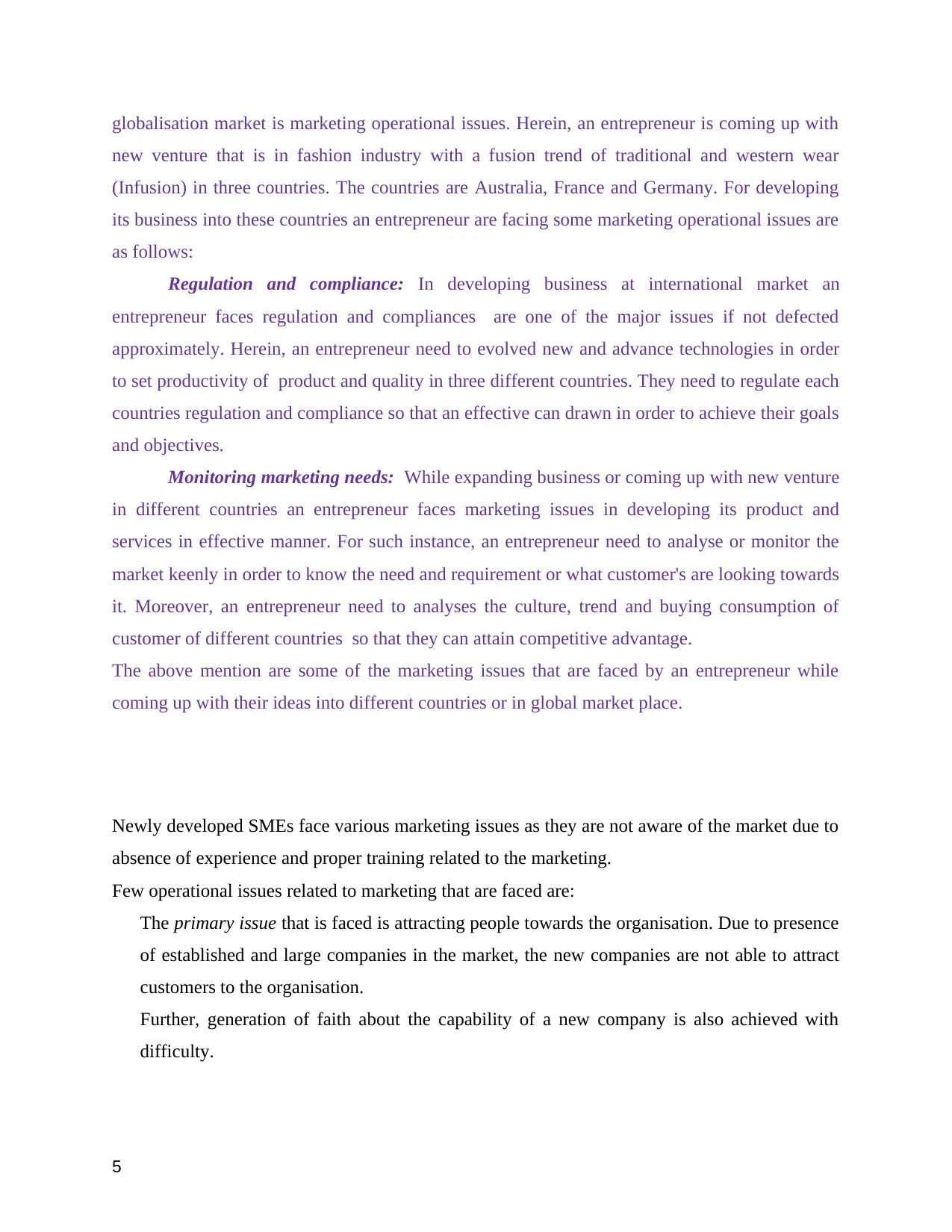
globalisation market is marketing operational issues. Herein, an entrepreneur is coming up with
new venture that is in fashion industry with a fusion trend of traditional and western wear
(Infusion) in three countries. The countries are Australia, France and Germany. For developing
its business into these countries an entrepreneur are facing some marketing operational issues are
as follows:
Regulation and compliance: In developing business at international market an
entrepreneur faces regulation and compliances are one of the major issues if not defected
approximately. Herein, an entrepreneur need to evolved new and advance technologies in order
to set productivity of product and quality in three different countries. They need to regulate each
countries regulation and compliance so that an effective can drawn in order to achieve their goals
and objectives.
Monitoring marketing needs: While expanding business or coming up with new venture
in different countries an entrepreneur faces marketing issues in developing its product and
services in effective manner. For such instance, an entrepreneur need to analyse or monitor the
market keenly in order to know the need and requirement or what customer's are looking towards
it. Moreover, an entrepreneur need to analyses the culture, trend and buying consumption of
customer of different countries so that they can attain competitive advantage.
The above mention are some of the marketing issues that are faced by an entrepreneur while
coming up with their ideas into different countries or in global market place.
Newly developed SMEs face various marketing issues as they are not aware of the market due to
absence of experience and proper training related to the marketing.
Few operational issues related to marketing that are faced are:
The primary issue that is faced is attracting people towards the organisation. Due to presence
of established and large companies in the market, the new companies are not able to attract
customers to the organisation.
Further, generation of faith about the capability of a new company is also achieved with
difficulty.
5
new venture that is in fashion industry with a fusion trend of traditional and western wear
(Infusion) in three countries. The countries are Australia, France and Germany. For developing
its business into these countries an entrepreneur are facing some marketing operational issues are
as follows:
Regulation and compliance: In developing business at international market an
entrepreneur faces regulation and compliances are one of the major issues if not defected
approximately. Herein, an entrepreneur need to evolved new and advance technologies in order
to set productivity of product and quality in three different countries. They need to regulate each
countries regulation and compliance so that an effective can drawn in order to achieve their goals
and objectives.
Monitoring marketing needs: While expanding business or coming up with new venture
in different countries an entrepreneur faces marketing issues in developing its product and
services in effective manner. For such instance, an entrepreneur need to analyse or monitor the
market keenly in order to know the need and requirement or what customer's are looking towards
it. Moreover, an entrepreneur need to analyses the culture, trend and buying consumption of
customer of different countries so that they can attain competitive advantage.
The above mention are some of the marketing issues that are faced by an entrepreneur while
coming up with their ideas into different countries or in global market place.
Newly developed SMEs face various marketing issues as they are not aware of the market due to
absence of experience and proper training related to the marketing.
Few operational issues related to marketing that are faced are:
The primary issue that is faced is attracting people towards the organisation. Due to presence
of established and large companies in the market, the new companies are not able to attract
customers to the organisation.
Further, generation of faith about the capability of a new company is also achieved with
difficulty.
5
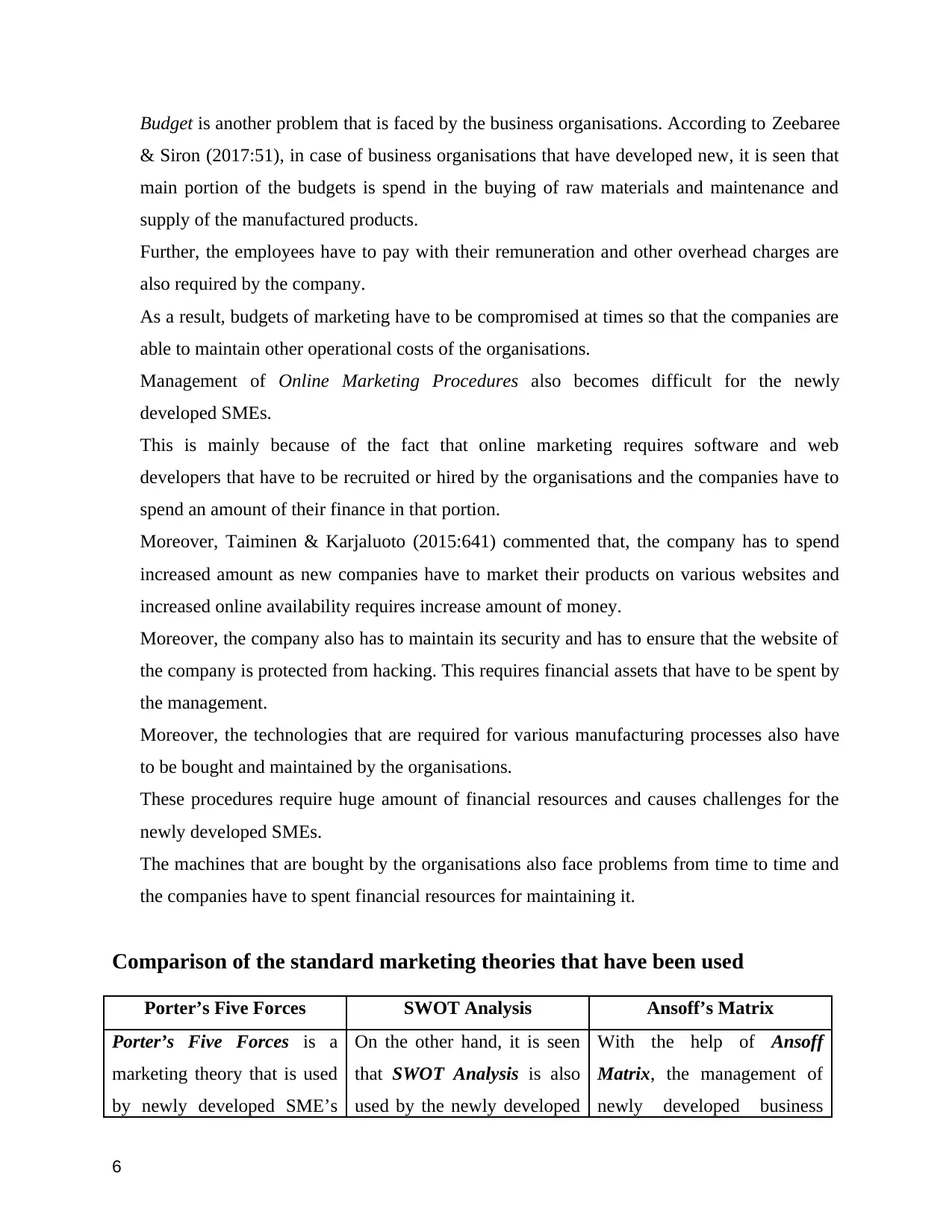
Budget is another problem that is faced by the business organisations. According to Zeebaree
& Siron (2017:51), in case of business organisations that have developed new, it is seen that
main portion of the budgets is spend in the buying of raw materials and maintenance and
supply of the manufactured products.
Further, the employees have to pay with their remuneration and other overhead charges are
also required by the company.
As a result, budgets of marketing have to be compromised at times so that the companies are
able to maintain other operational costs of the organisations.
Management of Online Marketing Procedures also becomes difficult for the newly
developed SMEs.
This is mainly because of the fact that online marketing requires software and web
developers that have to be recruited or hired by the organisations and the companies have to
spend an amount of their finance in that portion.
Moreover, Taiminen & Karjaluoto (2015:641) commented that, the company has to spend
increased amount as new companies have to market their products on various websites and
increased online availability requires increase amount of money.
Moreover, the company also has to maintain its security and has to ensure that the website of
the company is protected from hacking. This requires financial assets that have to be spent by
the management.
Moreover, the technologies that are required for various manufacturing processes also have
to be bought and maintained by the organisations.
These procedures require huge amount of financial resources and causes challenges for the
newly developed SMEs.
The machines that are bought by the organisations also face problems from time to time and
the companies have to spent financial resources for maintaining it.
Comparison of the standard marketing theories that have been used
Porter’s Five Forces SWOT Analysis Ansoff’s Matrix
Porter’s Five Forces is a
marketing theory that is used
by newly developed SME’s
On the other hand, it is seen
that SWOT Analysis is also
used by the newly developed
With the help of Ansoff
Matrix, the management of
newly developed business
6
& Siron (2017:51), in case of business organisations that have developed new, it is seen that
main portion of the budgets is spend in the buying of raw materials and maintenance and
supply of the manufactured products.
Further, the employees have to pay with their remuneration and other overhead charges are
also required by the company.
As a result, budgets of marketing have to be compromised at times so that the companies are
able to maintain other operational costs of the organisations.
Management of Online Marketing Procedures also becomes difficult for the newly
developed SMEs.
This is mainly because of the fact that online marketing requires software and web
developers that have to be recruited or hired by the organisations and the companies have to
spend an amount of their finance in that portion.
Moreover, Taiminen & Karjaluoto (2015:641) commented that, the company has to spend
increased amount as new companies have to market their products on various websites and
increased online availability requires increase amount of money.
Moreover, the company also has to maintain its security and has to ensure that the website of
the company is protected from hacking. This requires financial assets that have to be spent by
the management.
Moreover, the technologies that are required for various manufacturing processes also have
to be bought and maintained by the organisations.
These procedures require huge amount of financial resources and causes challenges for the
newly developed SMEs.
The machines that are bought by the organisations also face problems from time to time and
the companies have to spent financial resources for maintaining it.
Comparison of the standard marketing theories that have been used
Porter’s Five Forces SWOT Analysis Ansoff’s Matrix
Porter’s Five Forces is a
marketing theory that is used
by newly developed SME’s
On the other hand, it is seen
that SWOT Analysis is also
used by the newly developed
With the help of Ansoff
Matrix, the management of
newly developed business
6
⊘ This is a preview!⊘
Do you want full access?
Subscribe today to unlock all pages.

Trusted by 1+ million students worldwide
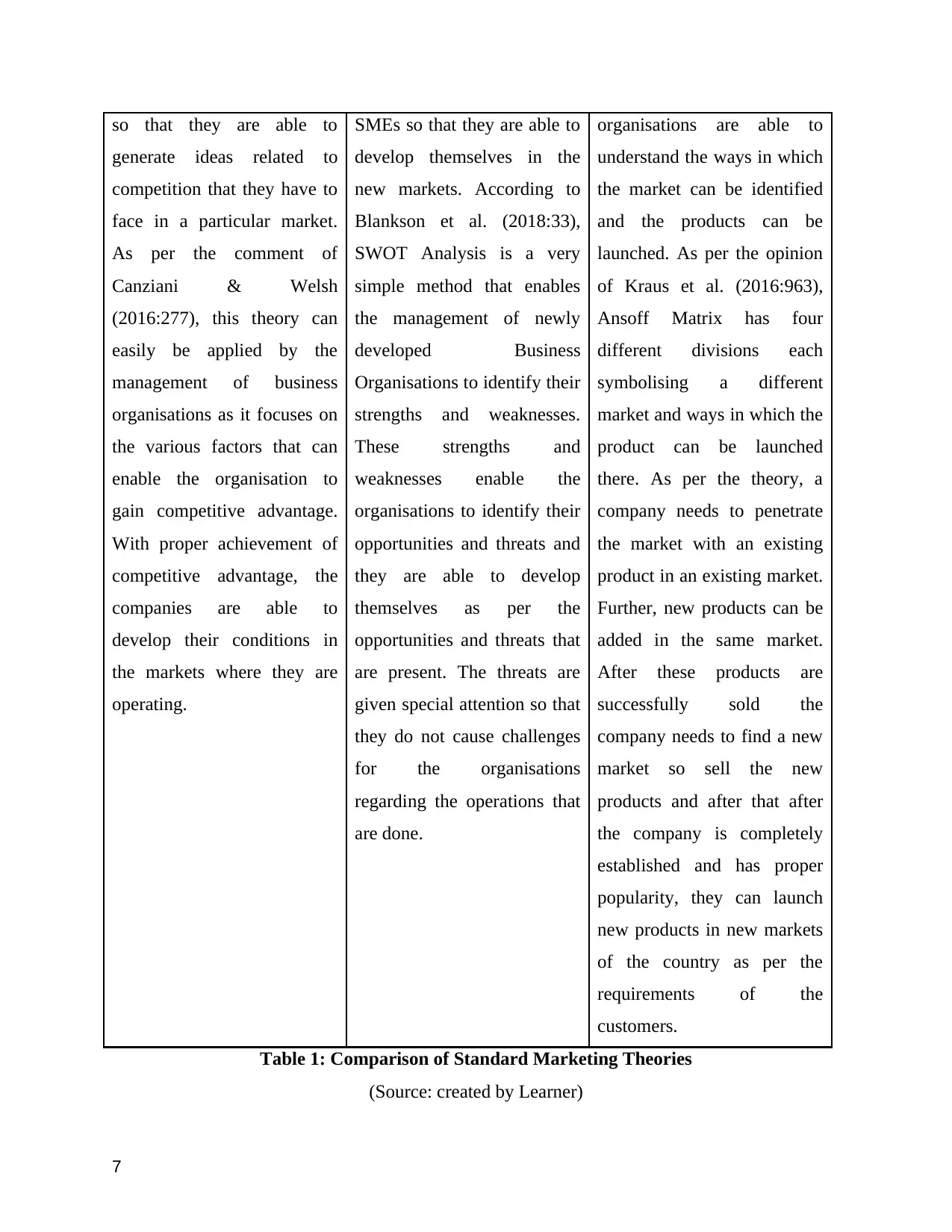
so that they are able to
generate ideas related to
competition that they have to
face in a particular market.
As per the comment of
Canziani & Welsh
(2016:277), this theory can
easily be applied by the
management of business
organisations as it focuses on
the various factors that can
enable the organisation to
gain competitive advantage.
With proper achievement of
competitive advantage, the
companies are able to
develop their conditions in
the markets where they are
operating.
SMEs so that they are able to
develop themselves in the
new markets. According to
Blankson et al. (2018:33),
SWOT Analysis is a very
simple method that enables
the management of newly
developed Business
Organisations to identify their
strengths and weaknesses.
These strengths and
weaknesses enable the
organisations to identify their
opportunities and threats and
they are able to develop
themselves as per the
opportunities and threats that
are present. The threats are
given special attention so that
they do not cause challenges
for the organisations
regarding the operations that
are done.
organisations are able to
understand the ways in which
the market can be identified
and the products can be
launched. As per the opinion
of Kraus et al. (2016:963),
Ansoff Matrix has four
different divisions each
symbolising a different
market and ways in which the
product can be launched
there. As per the theory, a
company needs to penetrate
the market with an existing
product in an existing market.
Further, new products can be
added in the same market.
After these products are
successfully sold the
company needs to find a new
market so sell the new
products and after that after
the company is completely
established and has proper
popularity, they can launch
new products in new markets
of the country as per the
requirements of the
customers.
Table 1: Comparison of Standard Marketing Theories
(Source: created by Learner)
7
generate ideas related to
competition that they have to
face in a particular market.
As per the comment of
Canziani & Welsh
(2016:277), this theory can
easily be applied by the
management of business
organisations as it focuses on
the various factors that can
enable the organisation to
gain competitive advantage.
With proper achievement of
competitive advantage, the
companies are able to
develop their conditions in
the markets where they are
operating.
SMEs so that they are able to
develop themselves in the
new markets. According to
Blankson et al. (2018:33),
SWOT Analysis is a very
simple method that enables
the management of newly
developed Business
Organisations to identify their
strengths and weaknesses.
These strengths and
weaknesses enable the
organisations to identify their
opportunities and threats and
they are able to develop
themselves as per the
opportunities and threats that
are present. The threats are
given special attention so that
they do not cause challenges
for the organisations
regarding the operations that
are done.
organisations are able to
understand the ways in which
the market can be identified
and the products can be
launched. As per the opinion
of Kraus et al. (2016:963),
Ansoff Matrix has four
different divisions each
symbolising a different
market and ways in which the
product can be launched
there. As per the theory, a
company needs to penetrate
the market with an existing
product in an existing market.
Further, new products can be
added in the same market.
After these products are
successfully sold the
company needs to find a new
market so sell the new
products and after that after
the company is completely
established and has proper
popularity, they can launch
new products in new markets
of the country as per the
requirements of the
customers.
Table 1: Comparison of Standard Marketing Theories
(Source: created by Learner)
7
Paraphrase This Document
Need a fresh take? Get an instant paraphrase of this document with our AI Paraphraser
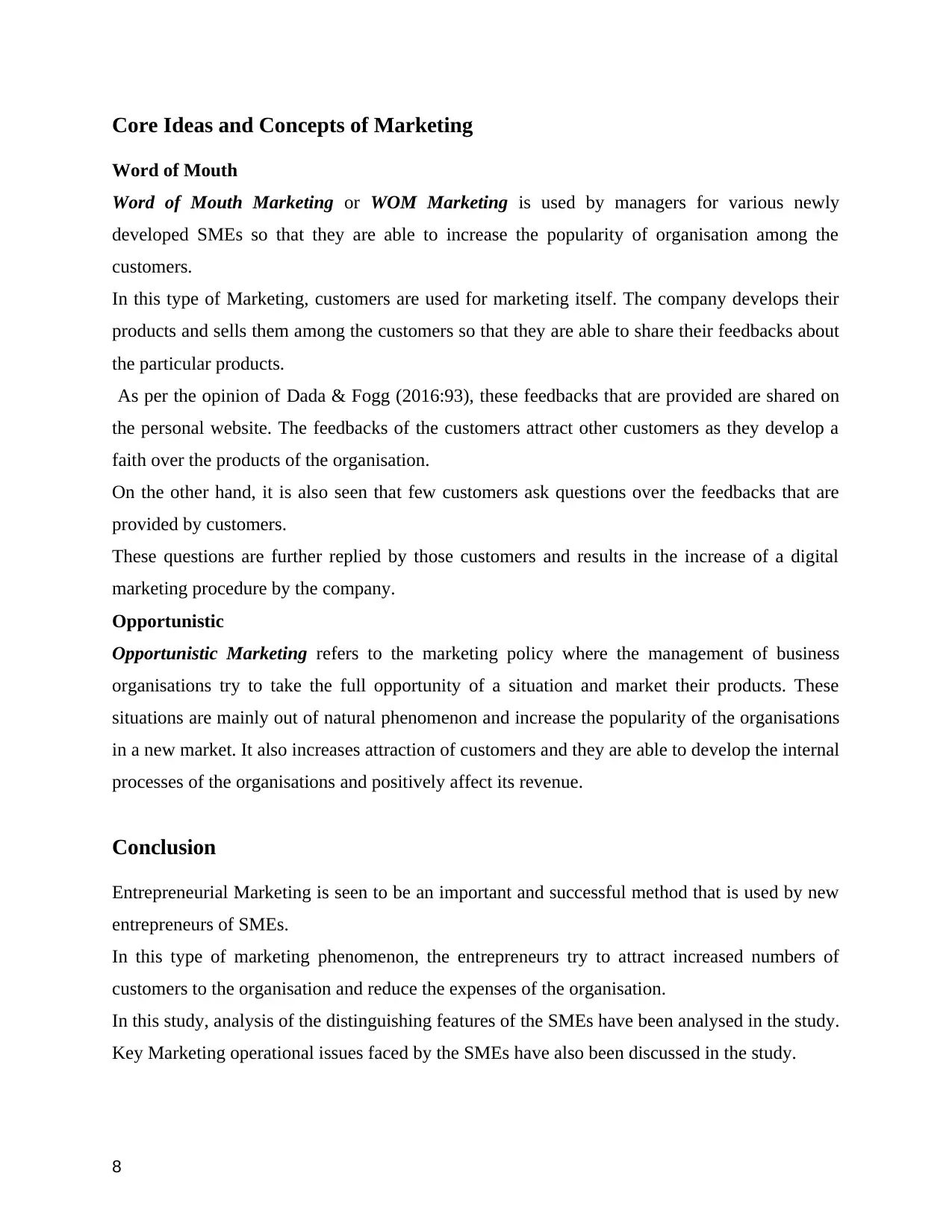
Core Ideas and Concepts of Marketing
Word of Mouth
Word of Mouth Marketing or WOM Marketing is used by managers for various newly
developed SMEs so that they are able to increase the popularity of organisation among the
customers.
In this type of Marketing, customers are used for marketing itself. The company develops their
products and sells them among the customers so that they are able to share their feedbacks about
the particular products.
As per the opinion of Dada & Fogg (2016:93), these feedbacks that are provided are shared on
the personal website. The feedbacks of the customers attract other customers as they develop a
faith over the products of the organisation.
On the other hand, it is also seen that few customers ask questions over the feedbacks that are
provided by customers.
These questions are further replied by those customers and results in the increase of a digital
marketing procedure by the company.
Opportunistic
Opportunistic Marketing refers to the marketing policy where the management of business
organisations try to take the full opportunity of a situation and market their products. These
situations are mainly out of natural phenomenon and increase the popularity of the organisations
in a new market. It also increases attraction of customers and they are able to develop the internal
processes of the organisations and positively affect its revenue.
Conclusion
Entrepreneurial Marketing is seen to be an important and successful method that is used by new
entrepreneurs of SMEs.
In this type of marketing phenomenon, the entrepreneurs try to attract increased numbers of
customers to the organisation and reduce the expenses of the organisation.
In this study, analysis of the distinguishing features of the SMEs have been analysed in the study.
Key Marketing operational issues faced by the SMEs have also been discussed in the study.
8
Word of Mouth
Word of Mouth Marketing or WOM Marketing is used by managers for various newly
developed SMEs so that they are able to increase the popularity of organisation among the
customers.
In this type of Marketing, customers are used for marketing itself. The company develops their
products and sells them among the customers so that they are able to share their feedbacks about
the particular products.
As per the opinion of Dada & Fogg (2016:93), these feedbacks that are provided are shared on
the personal website. The feedbacks of the customers attract other customers as they develop a
faith over the products of the organisation.
On the other hand, it is also seen that few customers ask questions over the feedbacks that are
provided by customers.
These questions are further replied by those customers and results in the increase of a digital
marketing procedure by the company.
Opportunistic
Opportunistic Marketing refers to the marketing policy where the management of business
organisations try to take the full opportunity of a situation and market their products. These
situations are mainly out of natural phenomenon and increase the popularity of the organisations
in a new market. It also increases attraction of customers and they are able to develop the internal
processes of the organisations and positively affect its revenue.
Conclusion
Entrepreneurial Marketing is seen to be an important and successful method that is used by new
entrepreneurs of SMEs.
In this type of marketing phenomenon, the entrepreneurs try to attract increased numbers of
customers to the organisation and reduce the expenses of the organisation.
In this study, analysis of the distinguishing features of the SMEs have been analysed in the study.
Key Marketing operational issues faced by the SMEs have also been discussed in the study.
8
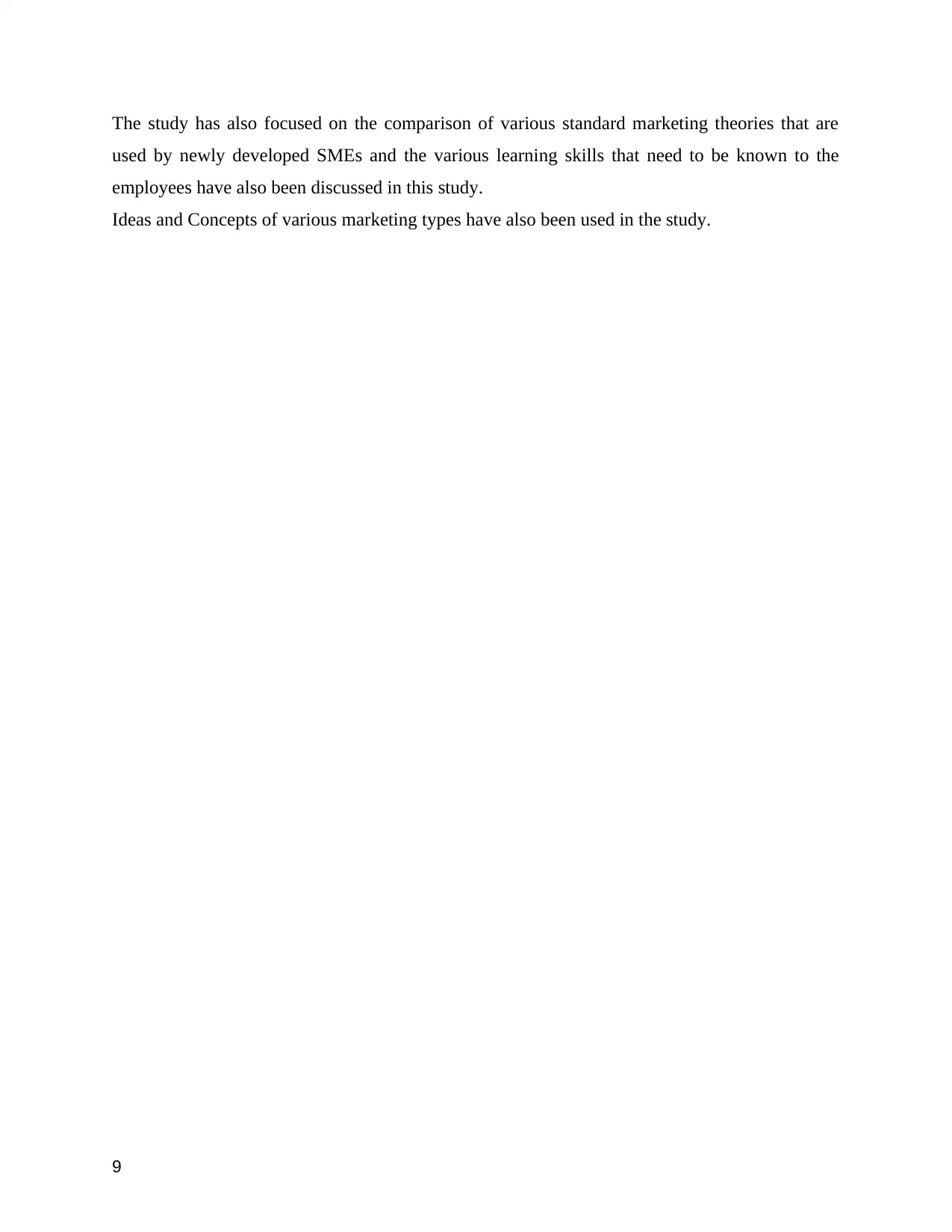
The study has also focused on the comparison of various standard marketing theories that are
used by newly developed SMEs and the various learning skills that need to be known to the
employees have also been discussed in this study.
Ideas and Concepts of various marketing types have also been used in the study.
9
used by newly developed SMEs and the various learning skills that need to be known to the
employees have also been discussed in this study.
Ideas and Concepts of various marketing types have also been used in the study.
9
⊘ This is a preview!⊘
Do you want full access?
Subscribe today to unlock all pages.

Trusted by 1+ million students worldwide
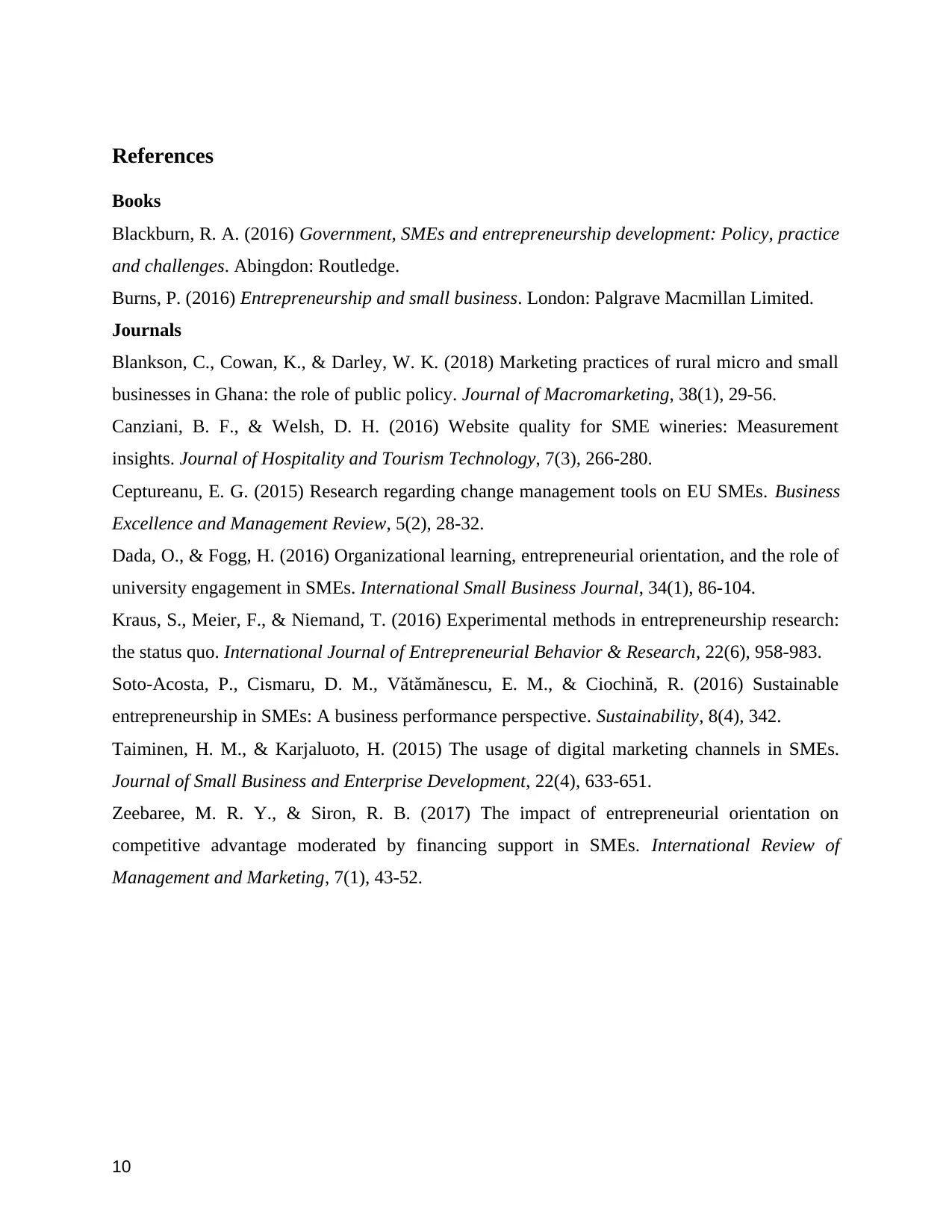
References
Books
Blackburn, R. A. (2016) Government, SMEs and entrepreneurship development: Policy, practice
and challenges. Abingdon: Routledge.
Burns, P. (2016) Entrepreneurship and small business. London: Palgrave Macmillan Limited.
Journals
Blankson, C., Cowan, K., & Darley, W. K. (2018) Marketing practices of rural micro and small
businesses in Ghana: the role of public policy. Journal of Macromarketing, 38(1), 29-56.
Canziani, B. F., & Welsh, D. H. (2016) Website quality for SME wineries: Measurement
insights. Journal of Hospitality and Tourism Technology, 7(3), 266-280.
Ceptureanu, E. G. (2015) Research regarding change management tools on EU SMEs. Business
Excellence and Management Review, 5(2), 28-32.
Dada, O., & Fogg, H. (2016) Organizational learning, entrepreneurial orientation, and the role of
university engagement in SMEs. International Small Business Journal, 34(1), 86-104.
Kraus, S., Meier, F., & Niemand, T. (2016) Experimental methods in entrepreneurship research:
the status quo. International Journal of Entrepreneurial Behavior & Research, 22(6), 958-983.
Soto-Acosta, P., Cismaru, D. M., Vătămănescu, E. M., & Ciochină, R. (2016) Sustainable
entrepreneurship in SMEs: A business performance perspective. Sustainability, 8(4), 342.
Taiminen, H. M., & Karjaluoto, H. (2015) The usage of digital marketing channels in SMEs.
Journal of Small Business and Enterprise Development, 22(4), 633-651.
Zeebaree, M. R. Y., & Siron, R. B. (2017) The impact of entrepreneurial orientation on
competitive advantage moderated by financing support in SMEs. International Review of
Management and Marketing, 7(1), 43-52.
10
Books
Blackburn, R. A. (2016) Government, SMEs and entrepreneurship development: Policy, practice
and challenges. Abingdon: Routledge.
Burns, P. (2016) Entrepreneurship and small business. London: Palgrave Macmillan Limited.
Journals
Blankson, C., Cowan, K., & Darley, W. K. (2018) Marketing practices of rural micro and small
businesses in Ghana: the role of public policy. Journal of Macromarketing, 38(1), 29-56.
Canziani, B. F., & Welsh, D. H. (2016) Website quality for SME wineries: Measurement
insights. Journal of Hospitality and Tourism Technology, 7(3), 266-280.
Ceptureanu, E. G. (2015) Research regarding change management tools on EU SMEs. Business
Excellence and Management Review, 5(2), 28-32.
Dada, O., & Fogg, H. (2016) Organizational learning, entrepreneurial orientation, and the role of
university engagement in SMEs. International Small Business Journal, 34(1), 86-104.
Kraus, S., Meier, F., & Niemand, T. (2016) Experimental methods in entrepreneurship research:
the status quo. International Journal of Entrepreneurial Behavior & Research, 22(6), 958-983.
Soto-Acosta, P., Cismaru, D. M., Vătămănescu, E. M., & Ciochină, R. (2016) Sustainable
entrepreneurship in SMEs: A business performance perspective. Sustainability, 8(4), 342.
Taiminen, H. M., & Karjaluoto, H. (2015) The usage of digital marketing channels in SMEs.
Journal of Small Business and Enterprise Development, 22(4), 633-651.
Zeebaree, M. R. Y., & Siron, R. B. (2017) The impact of entrepreneurial orientation on
competitive advantage moderated by financing support in SMEs. International Review of
Management and Marketing, 7(1), 43-52.
10
1 out of 10
Related Documents
Your All-in-One AI-Powered Toolkit for Academic Success.
+13062052269
info@desklib.com
Available 24*7 on WhatsApp / Email
![[object Object]](/_next/static/media/star-bottom.7253800d.svg)
Unlock your academic potential
Copyright © 2020–2025 A2Z Services. All Rights Reserved. Developed and managed by ZUCOL.





